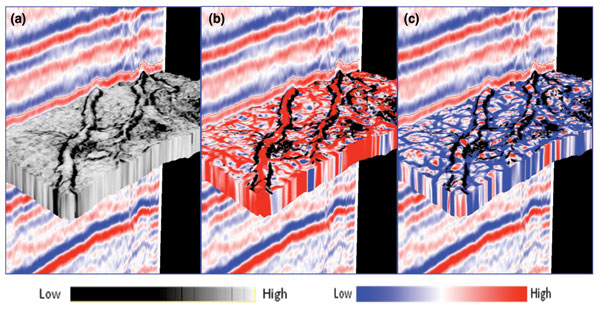![]() Click to view article in PDF format.
Click to view article in PDF format.
GCBlended Data Renders Visual Value*
Satinder Chopra1 and Kurt J. Marfurt2
Search and Discovery Article #40820 (2011)
Posted October 24, 2011
*Adapted from the Geophysical Corner column, prepared by the authors, in AAPG Explorer, October, 2011. Editor of Geophysical Corner is Bob A. Hardage ([email protected]). Managing Editor of AAPG Explorer is Vern Stefanic; Larry Nation is Communications Director.
1 Arcis Corp., Calgary, Canada ([email protected])
2 University of Oklahoma, Norman, Oklahoma
To co-render seismic attributes means to blend two or more seismic attributes into a single, unified data display. As a result of efforts to demonstrate the value of volumetric interpretation of seismic data, most modern software allows interpretation on time or horizon slices, together with geobody detection and multi-volume and multi-attribute co-rendering. Advanced display technology and visualization systems accelerate the interpretation process, create expanded insights into prospects and provide new means of communicating these insights to co-workers, management, partners and investors.
|
|
A false-color technique used to co-render seismic attributes plots three discrete attribute ranges using red, green and blue (RGB) colors:
From experiences of mixing paints, most people know how these three colors blend, which makes this RGB technique a powerful data-integration and communication tool. (The procedure has limited value, of course, for people who suffer from color blindness.) In the simplest implementation of RGB co-rendering, each voxel in 3-D space is assigned an RGB triplet, or color. When an interpreter displays a number of vertical and horizontal slices, or displays one or more 3-D seismic volumes, only data nearest the interpreter are seen. By extending this three-component color model to a four-component RGB-alpha color model, where alpha is opacity (or transparency), each voxel can be assigned a reflective or transmissive property of specific strength. Volume rendering consists of controlling the color and opacity of each voxel and projecting these properties onto an image plane. Such volume rendering allows interpreters to see and interact with features inside the 3-D volumes in their true 3-D perspective. By using opacity as a function of the value of a given attribute, an interpreter can highlight features of interest within a sub-volume of 3-D seismic data and facilitate the understanding of spatial relationships between features of interest. In Figure 1a we show a strat-cube sculpted from a most-positive principal curvature volume correlated with a vertical slice through a seismic amplitude volume. Note how lineaments of most-positive curvature correlate with anticline features seen on the vertical seismic slice. The opacity settings in Figure 1b create a skeletonized image of the larger flexures, which can be used to tie vertical slices through the seismic amplitude volume. In Figure 2a we show a chair view of a vertical slice through a seismic amplitude and a strat-cube extracted from the corresponding coherence volume. Note that two channel features are clearly seen in the middle of the strat-cube. These channels exhibit differential compactions, and the edges of the channels are well defined by low reflector coherence (black). Next we show the equivalent chair view, but with most-positive principal curvature (Figure 2b) and most-negative principal curvature (Figure 2c) co-rendered with coherence. Only very low values of coherence have been retained. High and intermediate coherence values have been made transparent. Note that the edges of the channels are again well-defined on the coherence surface. The channels appear as trends in which most-positive curvatures have their maximum positive values. Our tentative interpretation is that these are two sand-prone channels incised in a shale matrix that has undergone differential compaction. Consistent with this interpretation, the most-negative curvature anomalies define the edges of the channels (Figure 2c). In Figure 3a we show an inline vertical slice and a phantom horizon slice 8 ms below an interpreted zero crossing. In Figure 3b we show an equivalent chair view where the phantom horizon slice is correlated with most-positive and most-negative curvature volumes. Using transparency, we have retained only the higher positive values of most-positive curvature and the lowest negative values of most-negative curvatures. This co-rendered display shows red lineaments associated with the upthrown sides of the faults and blue lineaments associated with downthrown sides. Such displays convey more information than do strat-cube displays made from seismic attribute or curvature attribute volumes.
Copyright © AAPG. Serial rights given by author. For all other rights contact author directly. |

 General statement
General statement

